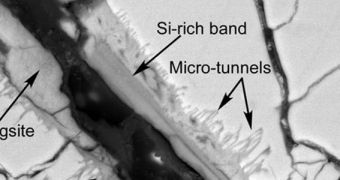A new scientific investigation led by researchers at the NASA Jet Propulsion Laboratory (JPL) in Pasadena, California, and the Johnson Space Center (JSC) in Houston, Texas, has revealed evidence that water moved through an ancient meteorite that arrived here on Earth from Mars.
Over the years, scientists found numerous meteorites at various locations around the world. In recent times, studies revealed that some of these space rocks were in fact pieces of the Red Planet that were cast away from our neighboring world following asteroid impacts and that eventually made their way here after wandering through the solar system for millions of years.
Back in 1996, a team of JSC scientists led by experts David McKay, Everett Gibson, and Kathie Thomas-Keprta published in the journal Science evidence that the meteorite called Allan Hills 84001 (ALH84001) once had water flowing through it.
The new study, led by Gibson, analyzed another Martian meteorite, called Yamato 000593 (Y000593). The 13.7-kilogram (30-pound) space rock revealed a series of structures and features that suggest the existence of biological processes on Mars many hundreds of millions of years ago.
McKay, Gibson, Thomas-Keptra, and JSC colleague Simon Clemett are all coauthors on the new study, which was published in the February issue of the journal Astrobiology. The lead author of the research is JPL investigator Lauren White.
“While robotic missions to Mars continue to shed light on the planet's history, the only samples from Mars available for study on Earth are Martian meteorites. On Earth, we can utilize multiple analytical techniques to take a more in-depth look into meteorites and shed light on the history of Mars,” White says.
“These samples offer clues to the past habitability of this planet. As more Martian meteorites are discovered, continued research focusing on these samples collectively will offer deeper insight into attributes which are indigenous to ancient Mars,” the investigator explains.
The beauty of having missions such as Curiosity and Opportunity (both of which are managed by JPL) on Mars is that meteorite data collected on Earth can be cross-referenced to readings taken by rovers and orbiters around the Red Planet.
If there are any clear signs of a wetter past on Mars, then these assets are likely to discover it. Curiosity and Opportunity are supported from orbit by the NASA Mars Reconnaissance Orbiter (MRO) and Mars Express, and by the European Space Agency's (ESA) Mars Express orbiters.
The new study again highlights the importance of a sample-return mission to the Red Planet, to deliver actual soil and rock samples from the surface of Mars to laboratories here on Earth.

 14 DAY TRIAL //
14 DAY TRIAL //